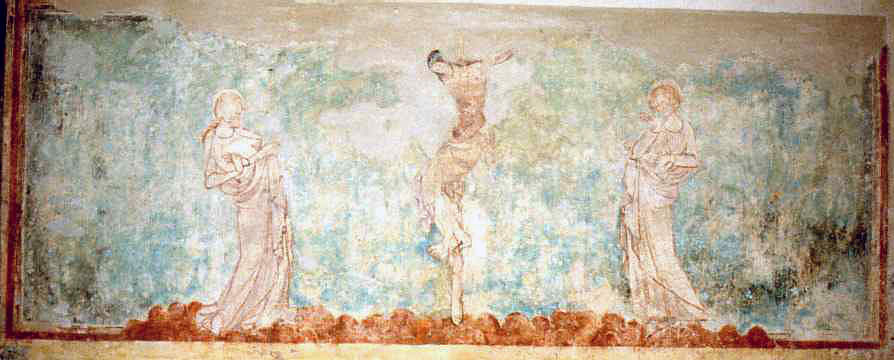Brent Eleigh, Suffolk (†St Edmundsbury & Ipswich) Early C.14
The Crucifixion, with Mary and John

This is a painted altarpiece or reredos, one of the few from any period actually painted on the wall behind the high altar. It probably dates from the early 14th century and it is high-quality work comparable, as the art historian Pamela Wedgwood suggested after its discovery in 1960, to such paintings as the Thornham Parva (Suffolk) retable and that at Dorchester Abbey in Oxfordshire, both of them contemporary. The figures of the crucified Christ, the Virgin Mary (left) and St John (right) are elegantly poised in the sinuous S-curve characteristic of their period, with the folds of the robes in flowing, graceful configuration. The green (probably malachite) background, patchy now with age, is unusual in parish church paintings of any date – paintings that have it are often of fine quality.
As a subject it needs little explanation and this treatment represents the Crucifixion in its purest, most ‘devotional’ painted form, without legendary or accreted elements to obscure the re-enactment of it taking place on the High Altar immediately below.
The two paintings flanking this one are also of great interest They are a painted background to a statue of the Virgin, with Angels and a battered but very high quality Harrowing of Hell.
Among other remarkable features in the Church (many are still there) was once a substantial parochial library, built in 1720. This was made to house the bequest of Henry Colman, D.D, a learned divine who was also Squire of Brent Eleigh. Very late in the 19th century the antiquarian MR James found in the library the unique manuscript, written by Thomas of Monmouth in the 12th century, of the life and miracles of St William of Norwich, the boy said to have been murdered by the Jews of Norwich in 1144².
¹ Canon John Fitch, MA, Brent Eleigh, An Illustrated History and Guide, 1986, pp.11-12
² MR James, Suffolk & Norfolk, 1930, p.18